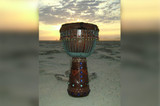What to Do When you Break Your Drum
Perhaps one of the most traumatic moments in a drummer’s life is when a drum is broken. These percussion instruments are more than tools of rhythm; they are family members. A broken drum not only reduces the potential to master a drum solo or show off a new fill in front of friends, it can change a person’s perspective on life entirely, and not for the better. Since broken drums are no laughing matter, knowing what to do when you break your drum can be the difference between a very bad day, and a day with just a slight hiccup.
Sometimes, a drum can be fixed by its owner, which is the best case scenario in terms of cost and the time lost with a favored drum. For drum shell repairs, it may come down to the materials used in the construction of the drum to determine the best way to fix the break. Wooden shell drums, like classic drum sets or djembe drums, may be easier to fix at home with glue or putty, especially if the appearance of the drum is less of a factor than getting back into the groove. Fiberglass or other drum shell materials can require the assistance of a professional to repair.
Drum heads obviously take most of the beating by the drummer, and are more likely to split, crack or tear than the drum shell. For natural skin drum heads, like those on a djembe drum or bongos, small cracks and tears can be filled in with glue, while larger holes could be patched with extra skin. However, both of these methods could change the sound of the drum, and completely replacing the natural skin drum head may have better results.
Synthetic drum heads can be patched with tape, but, it is always recommended that a patch kit is used in order to retain as much sound quality as possible. As with natural skin drum heads, the best way to keep your personal sound together after a broken drum incident is to replace the drum head all together. Additionally, for any drums played together (drum sets, bongos, congas, etc.), consider replacing all of the drum heads at the same time to keep the same sound quality alive.
The best advice for a broken drum is not to panic. Drums break, and while it can be a sad time in any drummer’s life, there are steps that can be taken to eliminate as much discomfort as possible. When in doubt, take your drum to an experienced repair professional and always remember that through proper care and maintenance of your drums, your drum’s health and safety will be better protected.
Recent Posts
-
What is the Best Size Djembe for Beginners?
If you're new to the world of percussion and interested in learning the djembe, you're in for a t …16th Jul 2024 -
The Benefits of Becoming a Drumming Teacher: Transforming Passion into Profession
Why become a drumming teacher? Becoming a drumming teacher is an excellent way to share your pas …22nd May 2024 -
What Makes the Djembe Drum a Spiritual Instrument in African Music?
Origin and history of the Djembe drum The Djembe drum originates from West Africa and holds sign …16th May 2024



